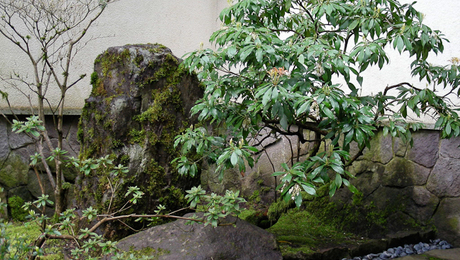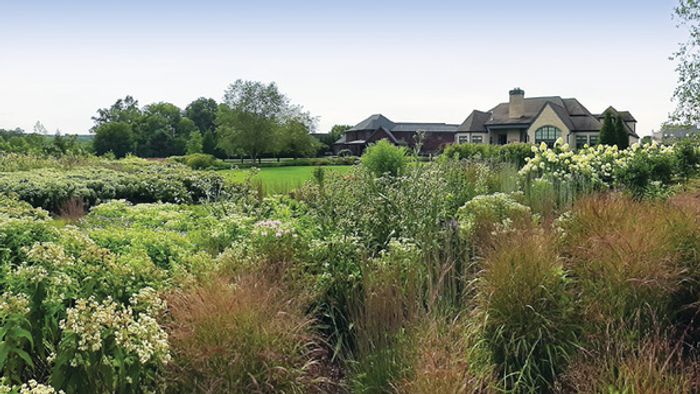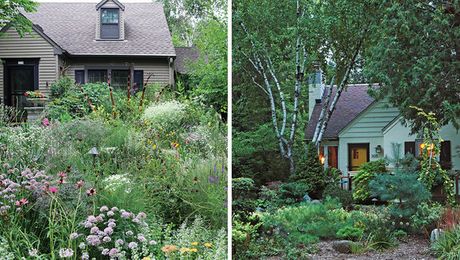
One of the first things I think about when I’m designing a new garden is what I call the “space-to-stuff” ratio. Will the garden look like a scene from a Tarzan movie, stuffed with plants and needing a machete to clear the way? Or will it have a Zen-like feel, using a few well-chosen elements, subtly arranged to create a feeling of calmness and uncluttered elegance? Maybe it will fall somewhere in between.
Space refers to anywhere you can move around without banging your shins on the patio furniture or snagging your sweater on a rose bush. I’m talking about paths, patios, lawns, low swaths of ground cover, etc. Everything else is stuff: tables and chairs, trees and shrubs, fountains and sculptures.
How these spaces and elements are arranged depends on the style of garden you seek. Formal gardens are often arranged on a grid and have a real or implied axis running down the center (sometimes perpendicular cross-axes, if you really want to get schmancy). Informal, or naturalistic gardens emulate a more organic flow of space, with curving lines and irregular balancing of the visual mass.
Look at the gardens you covet and figure out how this principle applies to them. Getting this fundamental concept right is crucial to meeting your aesthetic and practical goals.

This serene vista, taken at the Bloedel Reserve on Bainbridge Island, Washington, captures the concept of space, punctuated with a subtle inclusion of a cluster of trees and framed by screening plants tapering toward the horizon. Unfortunately, not all of us have the Puget Sound as a focal point, but it’s helpful to understand how the ratio of mass and space can be used to guide the eye. Additionally, gentle contouring of the ground plane at the edges focuses the viewer toward the long horizon. How would you rescale this idea in a smaller garden?

When you look at a garden you like, try to determine the stuff-to-space ratio. Susan Harris, one of those wild and crazy ladies at GardenRant.com, created this simple back yard lawn alternative a few years ago at her home outside D.C. She removed a traditional turf lawn and replaced it with sedum, clover, and a few other low-care ground covers. The edge is amorphous, sometimes creeping into the shrub beds. Medium shrubs and stout perennials form the musculature, eventually giving way to large shrubs and forest. There’s a feeling of openness leading to a simple path wandering into the trees. To me, the ratio of this vignette looks like 20% stuff, 80% open space. Does this work for you?

Back at the Bloedel Reserve, the Japanese garden offers an example of how line and space interact. The path appears to be deflected off the groupings of boulders and the occasional lone plant keeps the space from being completely revealed in one view. Also, notice how the low branches of the tree form a frame and contain the space.

When I spoke at Descanso Gardens in the Los Angeles area last year, I had a few hours to walk the grounds. This very residential composition takes the idea of a curving path and plants a few steps further. The bends in the flagstone walkway are more emphatic. Plants force a game of hide and seek. Low ground covers are minimized and the core plantings roll right up to the walkway, creating a feeling of compression, very unlike the example above. Is one better than the other? It’s all a matter of taste and your intention.

At Filoli, a historic estate about 30 miles south of San Francisco, the same idea is expressed using a formal, geometric layout. Clipped boxwood defines the separation of mass and space. A big show of potted tulips and the stone column tease visitors, obscuring the gate and the view beyond. Massive cylindrical shrubs anchor and balance the garden. Again, all these elements are scalable once you understand how they are being used to manipulate the proportions of the space.

Now let’s flip the equation and explore another part of the Bloedel Reserve. We find ourselves with a heaping helping of plants and a modest path sliding through the forest. The feeling is intimate and secretive, forcing visitors to slow down and appreciate the cool, misty woods.
So what have we learned? If you ask me, it’s a lesson about developing a grand scheme for the overall garden and organizing the space before jumping into creating beautiful foliage and floral compositions.
Fine Gardening Recommended Products

A.M. Leonard Deluxe Soil Knife & Leather Sheath Combo
Fine Gardening receives a commission for items purchased through links on this site, including Amazon Associates and other affiliate advertising programs.


















Comments
i always read this blog but this is my first comment/question. i "get" the stuff/space ratio but tell me what can we do with a client who freely admits she likes stuff? i mean LOTS of stuff? i try to hold her back, i try to keep things clean but there is always more and more stuff. have you discovered the magic to controlling this behavior or do we just have to smile, grit our teeth , move forward and deposit their checks? thanks for this blog, i have learned alot and it's always fun
tntreeman: Thanks for leaving a comment. I used to spend a lot of mental energy and had to dip into my forensic debating skills to find ways to help clients see the error of their ways. But for the past decade, I've taken the attitude that my job is a service provider who's there to help them accomplish something they feel they're not capable of doing on their own.
So I do what I call "Mirandizing" -- informing them of their "rights" to do things I don't necessarily agree with. If it's just about an aesthetic disagreement, I just tell them how I see it, but if they're not swayed, I assume the role of helping them achieve they're vision. It's easy, actually: they're the ones who live there, not me. The worst case scenario is that I might not want to photograph it for my portfolio.
In other cases, like when they want the finished garden to look "complete" the day it's installed (I call that HGTV Designer Challenge syndrome, which just caters to people's need for instant gratification), I explain the impacts, tell them that their garden will likely need a tremendous amount of maintenance, and will most likely look like an unhealthy jumble in very little time. As long as I feel I've cleared my conscience, I'm usually happy to, as you say, "move forward and deposit their checks."
That said, I have politely turned down clients whose vision and approach to their garden strongly disagreed from mine. Some lines can't be crossed, ethically speaking. I hope this helps. Thanks for reading and writing.
thx for the reply and i have been doing much the same,,,,,,,what else can one do!?!?!? i, too, have turned down a few jobs because i just couldn't allow myself to do it and i for sure didn't want anyone to KNOW i did it. people are funny sometimes i just have to shake my head, smile and move along. i keep saying i'm going to write a book about my past 25 years in business but i would have to leave the state.
make it a great week and have fun!
j
Wow, these are absolutely stunning gardens! I have always wanted an awesome landscape front and back of my house. I just purchased a fixer-uper home and I am now on the landscaping garden section of the fix-up. Does anyone know of any good places that do landscaping in ogden ut? Also, I admire what you do Billygoodnick!
Sillhouine: Sorry it's taken me so long to get back here. Busy boy. I wish I had some colleagues in the Ogden area, but that's a part of the country I haven't spent any time or made connections. Have you tried a visit to Houzz.com? They have portfolios for all types of design professionals and contractors, so you might get lucky.
Also, not to take advantage of my position here, but my new book "Yards" Turn Any Outdoor Space Into the Garden of Your Dreams" is full of useful ideas and takes you through the thought process a professional designer uses. Might be helpful. I hope this little bit of info puts you on the right track. And thanks for the "I admire what you do." I love doing it.
I've been reading lots of stuff here and this is my first time to comment.
I consider myself an urban farmer and find "space-to-stuff" ratio very much important as space is one of the biggest problems by urban farmers as written here: http://www.farmlanduk.com/grow-up/
Unlike Susan Harris, 20% stuff, 80% space wouldn't work for me but her garden looks gorgeous and perhaps 80% stuff, 20% space is the right ratio for me.
Having moved on too many occasions my first project was always the outside space. As a keen koi fish keeper, my main consideration has always been the koi pond so the 80-20 rule would not work for me in the way described above but the ratio suggested by susan vance works for me too. 80% koi pond 20% other stuff :o)
Robert
Log in or create an account to post a comment.
Sign up Log in